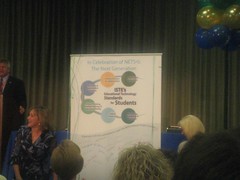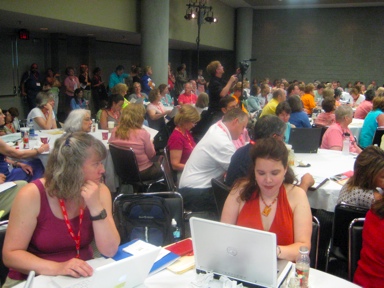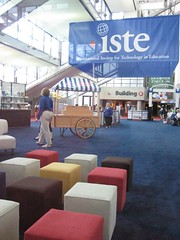 |
| Dave Jakes and I found this huge window at the conference center last night that opens onto an exhibitor’s hall, whose size is just barely hinted by this picture.
|
Will Richardson referred to a recent post by Lawrence Lessig yesterday (Bigger Challenges), where the Standford law professor has announced a shift in his academic and activist work, away from the persistent mis-match between our copyright laws and the information environment that they address, to a broader curruption of how things are done here (U.S. governments). These are my words, my interpretation. Please read Lessigs extended post, Required Reading: the next 10 years.
This shift in focus/mission is something that would catch Richardson’s ever observant eye. Not only does he confess that, “Lawrence Lessig is one of my heroes,” but this broadening focus is also something that Will has talked about in his writings and in his conversations with many of us.
Teachers and school leaders are a hard audience to reach. We work an education system that is not only seated in an archaic past with enormous momentum to resist change. But we are also operating within a political environment that seems to have its own reasons for hammering our schools, our administrators, our teachers, and our children down to a vision of teaching and learning that is shallow, rigid, dis-empowering, and oriented toward a past that seems to give us comfort and security — but no hope.
I respect and support anyone who is ready to commit themselves to knocking some of the rust off of the engine of politics, freeing it up adapt, empower, and to continue the great experiment. My focus will continue to be on school, classroom, and curriculum, because I believe that to affect change, we have to be able to describe an alternative to factory style education, one that is logical, adaptable, and compelling. I read, hear, and see a lot of great ideas out there, and even bold new practices from courageous educators. But I am not yet satisfied that we have that story.
I hope to learn some new technology here in Atlanta over the next several days. I already have. But even more important than that, I hope to (and challenge you to) look for that story, to expand and refine your vision of what teaching and learning really should look like and how it should behave in your home, a vision that fits today’s and tomorrow’s market place, that resonates with deeply held values, and a vision that we can describe and model.
We need to tell a story that dissolves education practices that distrust, insult, and punish teachers and learners — one that builds an education vision that empowers, respects, and celebrates meaningful learning experiences and the people who engage them.
2¢ Worth!
 Here’s a story from USAToday, just shared by Deneen Frazier Bowen, in one of her personae.
Here’s a story from USAToday, just shared by Deneen Frazier Bowen, in one of her personae.




 I decided early in this very active and interactive session, to trying to pull things together into some basic themes, and it became clear that we were not just talking about school. We were also talking about classrooms, teachers, and even future students. So I divided my summary into this breakdown.
I decided early in this very active and interactive session, to trying to pull things together into some basic themes, and it became clear that we were not just talking about school. We were also talking about classrooms, teachers, and even future students. So I divided my summary into this breakdown.


 I slept last night, in the room that I grew up in, two blocks from the train tracks. The 5:30 freight woke me up. When I was young, it was the 5:00 rooster, one block away.
I slept last night, in the room that I grew up in, two blocks from the train tracks. The 5:30 freight woke me up. When I was young, it was the 5:00 rooster, one block away.